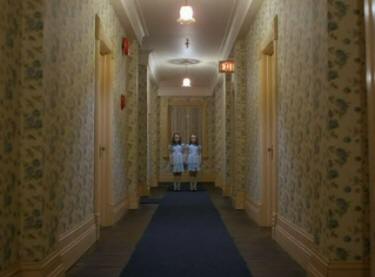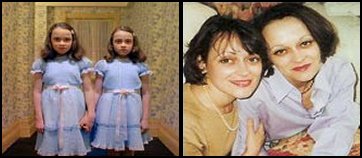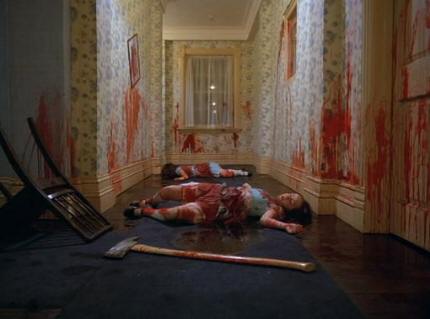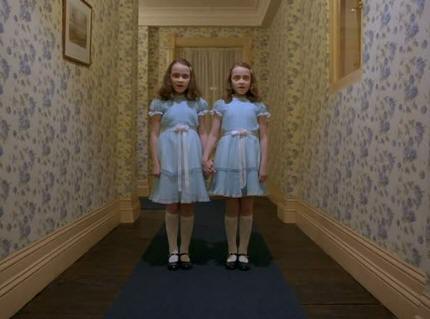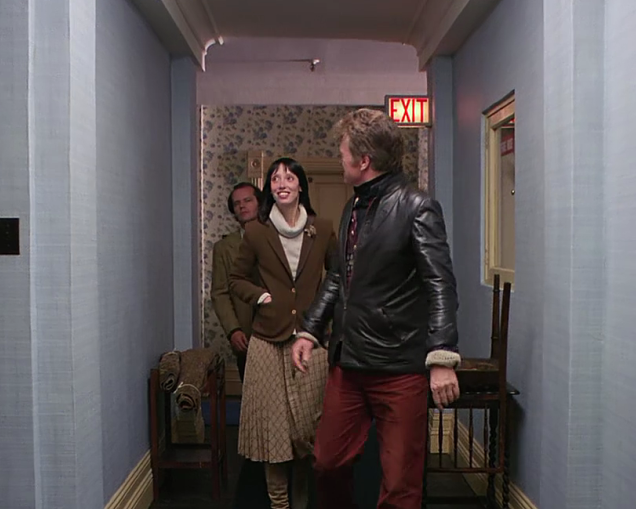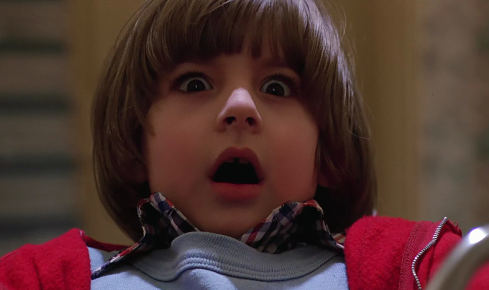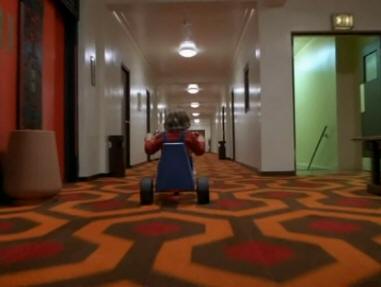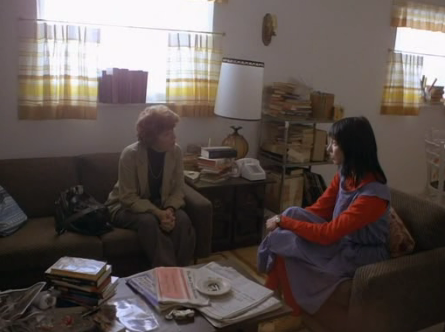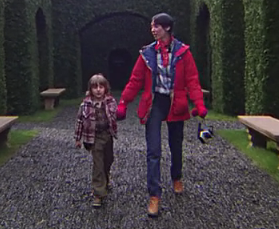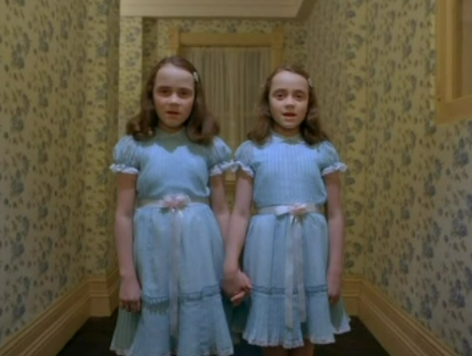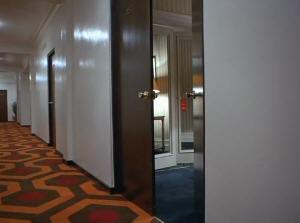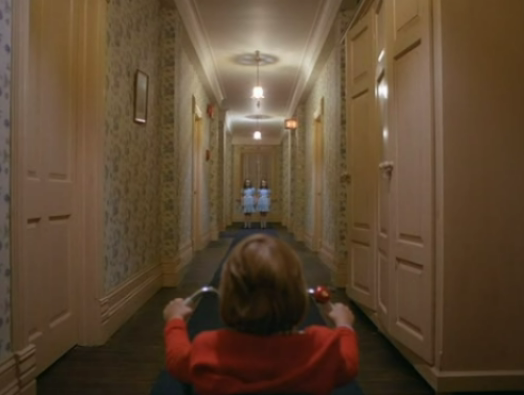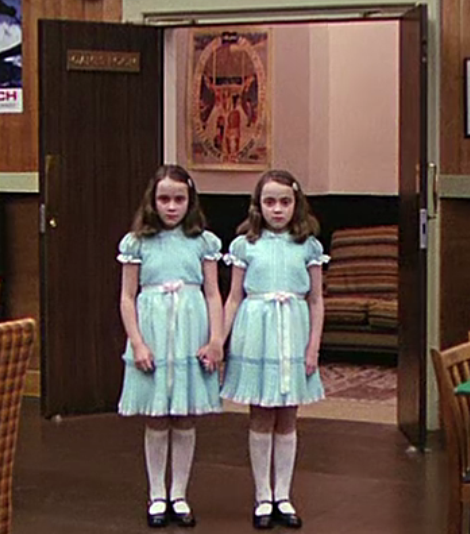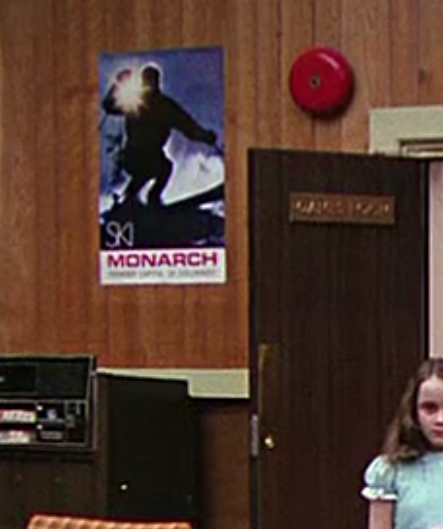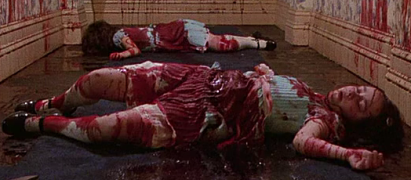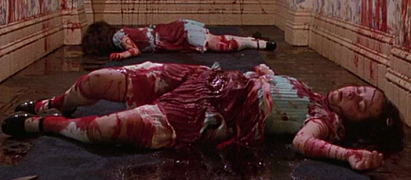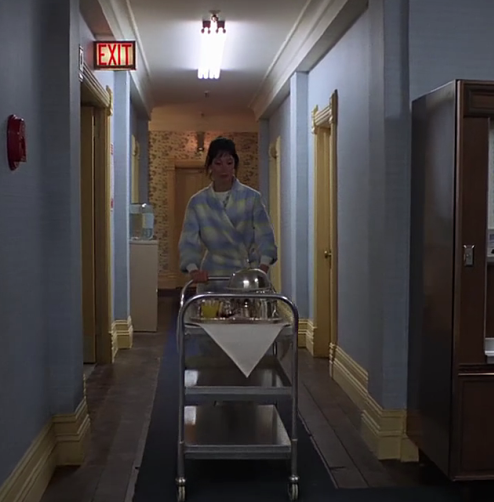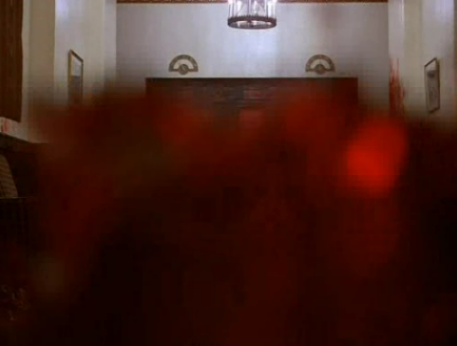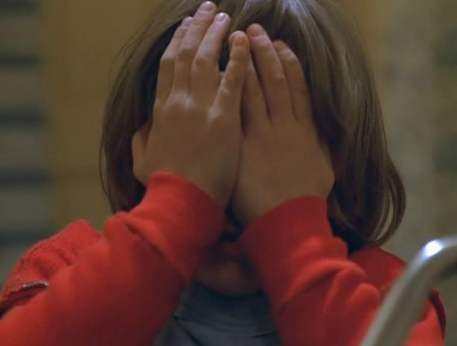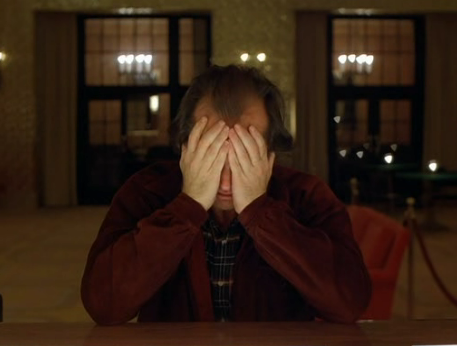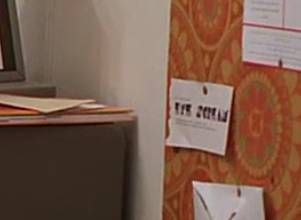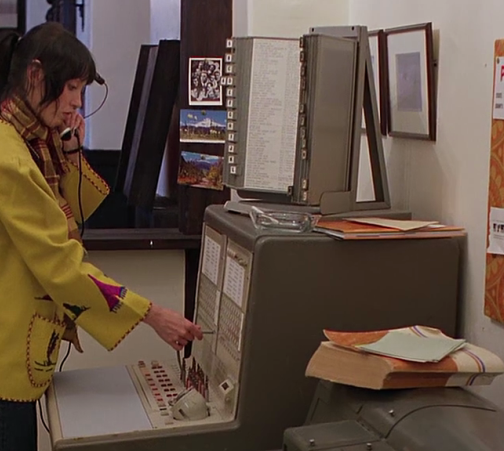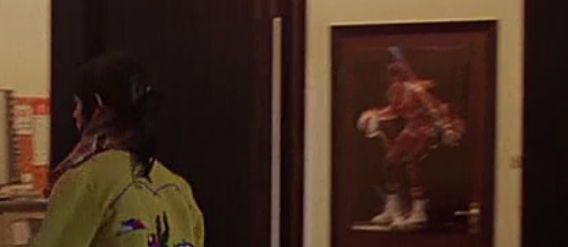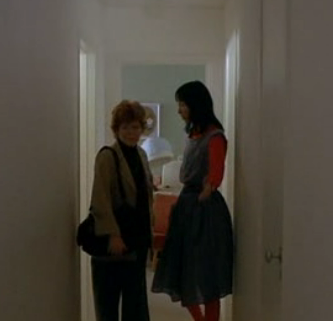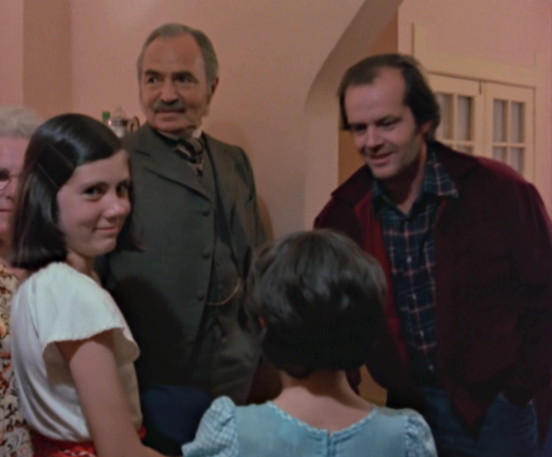CHAPTER TWENTY
Video supplement 1 - Mystery of the twins (this video covers most of the info in this chapter)
Video supplement 2 - Something in the River of Blood
You may have noticed that I’ve made very few references in this analysis to the subject of the twin girls who haunt Danny. No serious examination of the film would be satisfying without exploring the symbolism of the twins because the scene in which we see their blood-spattered corpses has scared the hell out of more audiences than any other scene in the film (the woman in the bath tub was the scene that gave me nightmares as a child). These twins are universally assumed to be Grady’s daughters, but quite simply they have nothing to do with the Grady family. The first detail that discredits the idea of them being Grady’s daughters is that Ullman described Grady as having “two little girls, about eight and ten”. In other words, Grady’s daughters were not twins. Ullman’s assumptions of different ages would be based upon visual differences in the girls’ appearance, but the girls Danny sees are definitely twins because Kubrick chose a pair of young twin actresses (Louise and Lisa Burns) to play them.
So if they’re not Grady’s daughters then who are they or who do they represent? The answers to this are complex because as is often the case with Kubrick, multiple metaphors are at work simultaneously. The first concept for decoding the twin scenes is to view them as the mirrored image of a single character. In the tricycle scene not only are they presented to us in symmetrical composition, but the hallway in which they are stood is also symbolically mirrored along the centre. They also speak identical lines of dialogue in sync and even their blood stained corpses are symbolically mirrored. One twin is face down and the other is face up, with their heads and feet on opposite sides of the screen and the limbs arranged identically. It’s as if during the process of being murdered their torsos have been spun along the centre axis of the screen.
The set design isn’t precisely mirrored along the central axis because there’s a connecting hallway to the left, but directly to the right of the hallway is a door with an exit sign above. This exit sign will become thematically important shortly.
We previously explored the use of moving furniture as representing people and in the dead twins scene we appropriately see a toppled, blood smeared chair in conjunction with the mutilated bodies of the girls. However, there is only one toppled chair, just as there is only one girl who is symbolically mirrored.
It’s also interesting in this scene that the apparent murder weapon, an axe, is so prominently displayed in front of the twins. In the close ups of the girls a glass covered alcove can be seen in the upper right. Is this a cabinet for the axe? If it is, why is the cabinet unopened in the shot of the murdered twins?
Another possible axe cabinet is shown outside the Torrance apartment, again on the right wall.
Kubrick also communicates the mirror symbology of the twins by associating them with other symmetrical compositions through simple editing. Shots of the twins are flashed on screen next to shots of the twin elevators and the low angle of the “Redrum” doorframe. We find more subtle hints of the twin / mirror concept during the room 237 hallway scenes. Most of the doorways in these halls are single doors, but room 237 features a double door, possibly implying a mirror. These doors are also polished and reflective (remember the cross symbology of doors and mirrors in chapter 5). When Danny turns the locked handle he is facing this polished double surface and so is facing his own reflection. It’s at this point that we cut to a shot of the twins – his own double reflection.
So on one level the twins represent Danny, perhaps accompanied by his imaginary friend. Rather than seeing the past, he is anticipating his own potential murder / abuse. He also saw the twins in his first shining vision, while looking into a mirror. And yet another supporting detail for this is that in the tricycle scene he wears a red jacket over a light blue sweater, just as the dead twins wear light blue dresses smeared in blood.
And then there's the blue seat of the tricycle, which against Danny's back gives him the appearance of wearing a blue dress.
The twins also represent Danny’s anticipation of his Mother being murdered. They have jet black hair like Wendy and they wear blue dresses. Wendy wears a blue dress at the start of the film with red stockings and sleeves, which gives her the symbolic appearance of an axe murdered twin.
When wandering the maze with Danny holding her hand she is again wearing red and blue.
In fact, with their creepily boy-like faces, the twins appear to be a synthesis of Danny and Wendy.
As Danny steps into the open doorway of room 237 he is approaching a set of angled mirrors that are about to show him a double reflection of himself, but he also shouts into the mirrors “Mom are you in there?” Possibly a double meaning as in asking if she is in the mirror as Danny's twin.
The slightly ajar doors and mirrors of the room 237 entrance were also paralleled when Danny encountered the twins – a large cupboard right screen had its doors slightly ajar.
There are many other scenes that reveal the mysterious twins as symbolizing Danny and Wendy. The boy and his Mother hold hands like the twins as Halloran walks them through the kitchen. While exploring the maze they again hold hands – a simple parallel of the twins walking in and out of the games room, trying to find their way out of the Overlook. Immediately after Danny sees the twins in the games room we cut to a shot of Ullman, Jack and Wendy in the hallway near the Torrance apartment – its background wallpaper is the same as that when we see the dead twins. And the next time we see Danny he is walking about holding hands with Ullman’s secretary Suzi. The games room is another multi-faceted twins scene. The twins turn their heads in mirrored fashion and smirk at each other. This time the set is not symmetrical, but the twins are positioned centre screen in a doorway, just as they were flashed on screen when Danny faced the room 237 doorway. The particular doors that we see at the games room entrance have the same polished colour as the room 237 doors. This may have been deliberate on Kubrick’s part.
The games room is also a direct parallel of the Colorado Lounge, which was Jack’s playroom. The Colorado Lounge had a US flag and a Colorado flag above Jack’s writing desk. These are also featured on the rear wall of the games room. A single red pool table is positioned near the elevator doors of the Colorado Lounge. Again, the games room has red pool tables. Danny throws darts at a board just before he sees the twins, while Jack threw a tennis ball repeatedly at the twin like native figures above the fireplace. The native aspect of the twins may also be present in that a small wall picture of a native child is briefly seen high up on the wall as Danny’s tricycle turns a corner to face the twins. In the games room notice also the strange use of a MONARCH mountain ski resort poster. The skier is a silhouetted figure with the sun blazing over his shoulder and his hand held up so that it overlaps his shoulder. Perhaps Kubrick chose this to suggest a shiny knife in the hand of a dark figure in a stabbing gesture.
Another theme possibly associated to the twins is the cross symbolism between murder and the sexual abuse experienced by Danny. The foreground figure of the slaughtered twins appears to have her dress pulled upward over her stomach and both twins have suffered injuries directly to their necks, while their lower torsos and genital regions are completely smeared in blood.
It’s strange that they would be killed in this way by the swings of an axe, so it may be a parallel of Danny ’s neck injury and sexual abuse. A supporting detail is that if we compare the four separate shots of the dead twins by flicking back and forth between them, we find that they’re not actually identical shots. The last three shots reveal the twins to be breathing … their stomach’s move. If you download the four images below and then flick through them with your windows picture viewer you'll notice the breathing pattern.
As tempting as it is to pass this off as a simple editing error, I have several additional observations that support the suggestion that the blood stained twins are alive.
So in the twins scenes Danny appears to be anticipating both sexual abuse and the possibility of murder. The twins ask Danny to come and play with them, and “play” is something we’ve already established as being linked to sex and murder in the film's symbology. Another noteworthy detail here is that the location of the dead twin halls is very close to the Torrance apartment. It’s orientation can be decoded by comparing it to two other shots – 1) Ullman walking the Torrance’s down a blue hall to view their apartment, and 2) Wendy pushing the breakfast tray out of an elevator near the Torrance apartment.
The most distant walls in the above shots feature the flowery white wall paper seen in the dead twins scene, but all of the other walls feature a simple sky blue colour, almost identical to the colour of the twins’ dresses. The L shape of the hallway that wraps around this location is where Danny's tricycle encounter with the twins occurred. Danny is riding in anti-clockwise circles outside the Torrance apartment. Hence he will be playing with twins “forever and ever” as he cycles around this unending hallway, each cycle taking him closer and closer to the twins. The camera shots steadily moving closer to the twins could also be suggesting the continuous movement of Danny’s tricycle, forever stuck in a loop and unable to escape the horrifying vision. Confirmation of this hallway arrangement can be seen left screen in the shot of the dead twins. The wallpaper in the hall from which the chair has toppled is sky blue, like the wallpaper outside the Torrance apartment.
And in the wider shots of the twins we see an “EXIT” sign directly above a door on the right wall.
This same sign is visible in the background as Wendy wheels the breakfast tray out of the elevator.
This looped hallway motif even explains why Kubrick used a wallpaper design that shows flowers arranged to look like question marks. He is teasing us to pay attention to the layout of the halls. Remember that in the maze chase at the end of the film Danny almost loops back upon his own tracks (see Chapter four), but breaks the pattern by turning right. If he hadn't done this he would have encountered Jack and been slaughtered. The same is true of the dead twins vision. In order to escape his endless left-turning loop of abuse, Danny must change directions and exit to his right. As if the dead twins scene wasn’t multi-layered enough, Kubrick has also linked it to the river of blood scene, which in itself has some impressive subliminals. One parallel is that as Danny first “shined” the red river, a wall of blood splashed up and blacked out the screen. This is also true of the dead twins scene, except that it's Danny’s hands which rise up and black out his vision.
Jack also did this when looking into a mirror in the Gold room. This parallels Danny's Shining visions of his abused / murdered self as well as the generational abuse cycle.
On a slightly different tangent regarding the river of blood, here’s a really impressive subliminal detail. The elevator door doesn’t open automatically. It’s a manual operation door. Watch Ullman opening the elevator door to the Colorado Lounge – he slides it open manually. If you look closely at the initial burst of blood that gushes out of the elevator, the door doesn’t open smoothly. It opens half way, pauses and then quickly opens the rest of the way. But how could it be manually opened from inside if it’s full of blood? Take a look at the floor directly beneath the opening door. An object or body flops out of the elevator in the initial bulge of blood. What appears to be its head and shoulders can then be seen on the floor for several seconds directly beneath the continuous waterfall of blood, but then the figure is obscured completely as blood splashes inwards from the walls (scroll to top of page to watch a detailed video regarding the object in the river of blood).
If the object flopping out of the elevator is a dead body then whose body is it? My guess is that it’s Danny’s imaginary friend Tony. Tony is described by Danny as “a little boy” who “hides in my stomach” and “lives in my mouth”. The elevator door and its floor dials we’ve already established as symbolizing Danny’s gaping mouth and eyes. Danny sees this vision while pressurizing Tony to reveal his fears about the hotel (and while talking to himself in a mirror). This I believe to be the visual revelation of Tony and his subtle presence can be noticed because the drenched body is “shining” under the elevator hall lights. The cutting of a close up of the twins with the river of blood also suggests that the twins represent a mirrored version of the body. Incidentally, a further link is made between the elevators and lavatories. During Wendy’s attempt to phone out from the Overlook (before entering Ullman’s office) a notice board is visible right screen. It features a small white card which reads the curious words “EYE SCREAM” (only readable in the HD release).
The obvious connection is that “eye scream” is a pun for “ice cream”. Halloran was heard whispering psychically to Danny, “How about some ice cream Doc?” He was actually speaking different dialogue to Wendy and a Native American chief was visible on a baking tin behind his head. So perhaps the voice isn’t Halloran’s. Perhaps it’s the Indian chief whispering “How about some I scream?” That ties in absolutely with the idea that the river of blood represents the blood of the slaughtered Indians. It was the Indian chief's voice we were hearing. The elevator itself is an “eye scream”. It has floor dials for eyes and it’s doors are a screaming mouth. The deafening rumble heard over the river of blood scene may even be the simultaneous screams of the natives, all heard in unison – too much for a human ear to take. But back to the lavatory connection. Wendy, in native-styled clothing, is trying to hear a phone reception on the switchboard, but can’t. Above the switchboard are two blue wall pictures in white frames placed close together.
These are the eyes and the switchboard is the mouth – the eye scream, except Wendy can’t hear anything, just as we the audience don’t notice the screaming native themes. In case you think the idea of the pictures as eyes and the switchboard as a mouth is corny, observe as Wendy walks away from the switchboard. Directly behind the wall where we saw the switchboard and “eye” pictures was a set of lavatory doors that are virtually identical to the “eye scream” elevators. They don’t have floor dials obviously, but the two “eye” pictures are still visible right screen through a window in the switchboard room.
The initial shot of Wendy at the switchboard also featured a slightly shaky, handheld camera position. This was very unusual for Kubrick. When the shot cuts away and Wendy walks out into the lobby we find that in the prior shot we were viewing Wendy from the point of view of a basket ball player who was featured on a poster in the switchboard room.
The poster was featured on a door, which the crew would have to have opened inwards to get the wide shot of Wendy at the switchboard. The basketball player is also clothed almost completely in red so, in conjunction with the unusual handheld camera work from the poster position, perhaps the basketball player is another subliminal hint of the blood stained body that flopped out of the elevator. Now we’ve slightly veered off from the subject of the twin girls, which is easy to do in a film so thickly layered with interlinking metaphors. I’ll now offer a few final observations about the twins before we move to the next chapter. An almost definite manifestation of the twins, the meaning of which has so far eluded me, is again visible in the HiDef release of The Shining. As Wendy and the psychiatrist leave Danny’s bedroom, his parent’s bedroom is visible through an open doorway in the background. On the furthest wall is a framed picture of two young children, a boy and a girl, clothed in blue. They aren’t mirrored images of each other though. It is a boy giving a flower to a girl. Beneath the picture are a few items of furniture including a single chair, perhaps a reference to the single chair that was near the dead twins.
Are we to take from this that Jack and Wendy are also represented by the twins? The only other supporting details I could find for this were that Jack and Wendy are both seen wearing a blue robe in different scenes (Jack speaks the line “forever and ever” while wearing the robe) and both of them “play” with Danny in different ways. Now here’s an oddity in the “making of” documentary that could very well be a reference to the twins. We’ve already discussed the symbology of Jack Nicholson being introduced to James Mason on set in that they both played sexually abusive father figures in Kubrick films. But also in the same scene Nicholson is introduced to a variety of other people who seem to be friends and relatives of James Mason. Among them are “two little girls about eight and ten” who are introduced as Katie and Liza. Katie, the older of the two, is almost a dead ringer for the twin girls of the film. She has her hair done in the same way with a white head band and she is facially very similar to them as well. We get a very good look at her because she glances straight into the camera for a moment. Her younger sister, Liza, doesn’t look anything like the twins, however her sky blue dress is almost identical to those worn by the twins.
How can this be? Was this whole "making of" scene scripted ... with actors stepping in to symbolically play out roles relating to the subliminal narrative of The Shining. Personally, I doubt it. A much more believable theory is that this visit to The Shining set by Mason and friends occurred before any of the twin girl scenes were shot. Kubrick may have observed these “two little girls about eight and ten” and then based the twin girls’ costumes and appearance upon Katie’s face and hair and Liza’s dress. If this was the case then it’s likely that James Mason was unknowingly being used by Kubrick to play Delbert Grady. As with any analysis of a Kubrick film, we’re forever stuck with speculation and little in the way of absolute proof. But here in this chapter we’ve hopefully decoded along the way most of, if not all, the meanings that Kubrick embedded in The Shining with relation to the twin girls.
|
